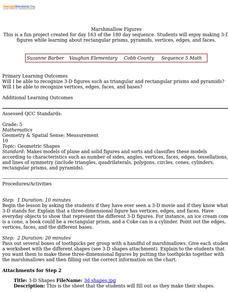Utah Education Network (UEN)
Insides and Outsides
Give small groups handfuls of unit cubes and then dare them to build as many rectangular prisms as possible using only 12 cubes. This engaging activity serves as an introduction to the volume of solid figures. In addition to volume,...
Curated OER
Marshmallow Figures
Students enjoy making 3-D figures while learning about rectangular prisms, pyramids, vertices, edges, and faces. After a lecture/demo, students use marshmallows, toothpicks and a worksheet imbedded in this lesson to create 3 dimensional...
University of Houston
Volume for Rectangular Prisms
Upper graders define perimeter and area of a rectangle, estimate numbers of cubes and determine the maximum amount that will fit in a given space. In this math lesson, pupils complete related worksheet, build prisms and find volume and...
Curated OER
Box It Up
Students calculate the surface area of prisms. In this geometry lesson, students investigate the properties of prisms and analyze ways to calculate the are of a rectangular prism. They derive the formula for surface area.
Curated OER
Calculating Volume
In this math worksheet, students complete 21 problems where they must find the volume of cubes and rectangular prisms. Since the formula for finding volume is such an important formula within geometry, this worksheet provides excellent...
Curated OER
Volume of Rectangular Prisms
Introduce the procedure needed to find the volume of a rectangular prism. Learners rank various prisms such as cereal boxes and tissue boxes from smallest to largest volume. They use an applet to find the volume and surface area of each...
Curated OER
Volumes of Rectangular Prisms
High schoolers determine the volume of a rectangular prism. They then maximize and minimize the volume given variable side lengths. Finally, they factor the volume equation to determine the side lengths.
Curated OER
Find the surface area of solids
In this online math learning exercise, high schoolers find the surface area of solid shapes given their dimensions. This excellent resource allows the students to check their answers, and to get "hints" should they run into difficulties....
Curated OER
Surface Area Formulas
In this geometry worksheet, students complete 21 problems where they find the surface area of pyramids, cubes, and rectangular prisms. This excellent worksheet would be an ideal quiz, or homework assignment.
Curated OER
Rectangular Prisms (I)
In this rectangular prisms activity, learners find the volume and surface area for the rectangular prisms. Students solve 3 problems.
Curated OER
Rectangular Prisms (E)
In this rectangular prisms worksheet, students find the volume and surface area for the rectangular prisms. Students solve 3 problems.
Curated OER
Rectangular Prisms (D)
In this volume and surface area activity, 7th graders find the volume and surface area for the rectangular prisms. Students solve 3 problems.
Curated OER
Rectangular Prisms (H)
In this rectangular prisms instructional activity, 7th graders find the volume and surface area of the rectangular prisms. Students solve 3 rectangular prisms problems.
Curated OER
Rectangular Prisms (C)
In this rectangular prisms worksheet, students use their problem solving skills to find the volume and surface area of 3 rectangular prisms.
Curated OER
Rectangular Prism Net
In this geometry worksheet, students cut out a rectangular prism net. They cut along the dotted lines as indicated the scissors icon, and fold the piece along the solid lines to form the three-dimensional shape. There are no directions...
















